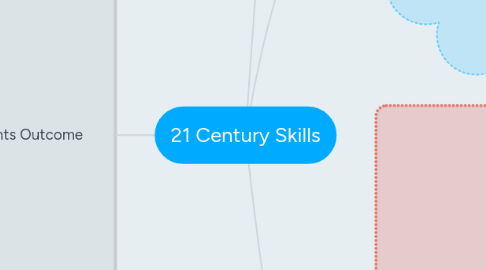
1. Definition
1.1. Integrates
1.1.1. Skills
1.1.2. Teaching
1.2. Describes
1.2.1. skills
1.2.2. knowledge
1.2.3. Expertise
1.2.4. To have
1.2.4.1. Success students
1.2.4.1.1. Also in today's worls
1.3. Make students
1.3.1. More engaged
1.3.2. More prepared
2. Students Outcome
2.1. Key subjects and 21st Century Themes
2.1.1. It includes
2.1.1.1. English, reading or art
2.1.1.2. World languages
2.1.1.3. Arts
2.1.1.4. Mathematics
2.1.1.5. Economics
2.1.1.6. Science
2.1.1.7. Geography
2.1.1.8. History
2.1.1.9. Government and civics
2.1.2. And also
2.1.2.1. Promote
2.1.2.1.1. Global Awareness
2.1.2.1.2. Financial, Economic, business
2.1.2.1.3. Civic Literacy
2.1.2.1.4. Health Literacy
2.1.2.1.5. Environmental Literacy
2.2. Learning and Innovation Skills
2.2.1. Creativity and innovation
2.2.1.1. Think creatively
2.2.1.1.1. Use Brainstorming
2.2.1.1.2. Create new ideas
2.2.1.1.3. to improve ideas
2.2.1.2. Work creatively with others
2.2.1.2.1. Communicate
2.2.1.2.2. Be open
2.2.1.3. Implement Innovations
2.2.1.3.1. Act on ideas
2.2.2. Critical thinking and problem solving
2.2.2.1. Use various types od reasoning
2.2.2.2. Analyze parts of interact
2.2.2.3. Judge and decide
2.2.2.4. Solve problems
2.2.3. Comunication and collaboration
2.2.3.1. Communicate clearly
2.2.3.1.1. Articulate
2.2.3.1.2. Listen
2.2.3.1.3. Use it for a purpose
2.2.3.1.4. Use technology
2.2.3.1.5. Do it in diverse environments
2.2.3.2. Collaborate
2.2.3.2.1. Work effectively and respectfully
2.2.3.2.2. Be flexible
2.2.3.2.3. Share responsibility
2.3. Information, media and technology skills
2.3.1. Information literacy
2.3.1.1. Access, evaluate, manage
2.3.1.1.1. Information
2.3.2. Media literacy
2.3.2.1. Analyze and Create
2.3.2.1.1. Media products
2.3.3. ICT
2.3.3.1. Apply technology effectively
2.3.3.1.1. As a tool
2.4. Life and Career Skills
2.4.1. Flexibility
2.4.1.1. Adapt
2.4.1.1.1. Roles, responsabilities, schedules, contexts
2.4.1.1.2. Work effectively and change priorities
2.4.1.2. Be flexible
2.4.1.2.1. Incorporate feednack
2.4.1.2.2. Deal positively
2.4.1.2.3. Understand, negotiate and balances
2.4.2. Iniciative
2.4.2.1. Manage
2.4.2.1.1. Goals
2.4.2.1.2. Time
2.4.2.2. Be independent
2.4.2.3. Be self-directed
2.4.2.3.1. Go beyond
2.4.2.3.2. Demonstrate
2.4.2.3.3. Inform future progress
2.4.3. Social skills
2.4.3.1. Interact and work
2.4.3.1.1. Effetively
2.4.3.1.2. Appropiate
2.4.3.1.3. Respect, respond opendly and create new ideas
2.4.4. Productivity
2.4.4.1. Manage projects
2.4.4.1.1. Set goals
2.4.4.1.2. Achieve the result
2.4.4.2. Produce results
2.4.4.2.1. Aditional attributes
2.4.5. Responsability
2.4.5.1. Guide and Lead
2.4.5.1.1. Influence and inspire
2.4.5.2. Be responsible
2.4.5.2.1. Act responsibly
3. Partnership for 21st Century Learning
3.1. Lerners need
3.1.1. educational experiences
3.1.2. To be
3.1.2.1. at school and beyond
3.1.3. from cradle to career
3.1.4. build
3.1.4.1. knowledge
3.1.4.2. skills
3.1.4.3. in a
3.1.4.3.1. globally interconnected world
3.1.4.3.2. digitally interconnected world
3.2. P21
3.2.1. Provides
3.2.1.1. Tools
3.2.1.2. Resources
3.2.1.3. To help with this change
4. Century Support Systems
4.1. Necessary to ensure student
4.1.1. Standards
4.1.1.1. Build understanding
4.1.1.2. Emphasize deep understanding
4.1.1.3. Engage students
4.1.1.3.1. solving meaningful problems
4.1.2. Assessment
4.1.2.1. Support
4.1.2.1.1. A balance of assassments
4.1.2.2. Give feedback
4.1.2.2.1. Into everyday learning
4.1.2.3. Balance
4.1.2.3.1. Technology-enhanced
4.1.2.4. Portfolios
4.1.2.4.1. Demonstrate mastery of 2st CS
4.1.2.5. Enable
4.1.2.5.1. Balance portfolio
4.1.3. Curriculum and Instruction
4.1.3.1. Focuses on
4.1.3.1.1. Provide opportunities
4.1.3.2. Innovative Learning methods
4.1.3.3. Encourage integration
4.1.3.3.1. Beyond school walls
4.1.4. Professional Development
4.1.4.1. Highlight ways
4.1.4.1.1. Integrating
4.1.4.2. Balance
4.1.4.2.1. Direct instructions
4.1.4.2.2. Project-oriented teaching methods
4.1.4.3. Ilustrate
4.1.4.3.1. Deeper understanding
4.1.4.4. Cultivate teachers
4.1.4.4.1. To identify students
4.1.4.4.2. Develop abilities
4.1.4.4.3. use strategies
4.1.4.5. Continuous evaluation
4.1.5. Learning Environments
4.1.5.1. Suport
4.1.5.1.1. Teaching and learning
4.1.5.1.2. Learning communities
4.1.5.1.3. Expanded community
4.1.5.1.4. International involvement
4.1.5.2. Enable students
4.1.5.2.1. Learn in relevant
4.1.5.2.2. Allow access
4.1.5.3. Provide
4.1.5.3.1. Architectural and interior designs
